Snowy owls are also called Great White owls due to their white plumage which helps them camouflage in the snowy environment. But where do they live?
Snowy owls are birds of the Arctic tundra, found only in the Northern hemisphere. They are unusual owls that do not inhabit dense forests but instead they prefer wide open areas. Snowy owls nest on the ground and they like having a good overview of their surroundings, so nests are usually located on a slight slope or hilltop.
Keep reading to find out more about the environment snowy owls inhabit, where they nest and why, and some curious notes on how you can spot them.
- Where Do Snowy Owls Live?
- What Is the Habitat of a Snowy Owl?
- Where Does a Snowy Owl Nest?
- Do Snowy Owls Hibernate or Migrate?
- Where Do Snowy Owls Come from?
- What Time of the Day is Best to See a Snowy Owl?
- Where Is the Best Place to See a Snowy Owl?
- Related Questions
- Do Snowy Owls Live in The Arctic or Antarctica?
- Can You See Snowy Owls in The United States?
- Do Snowy Owls Live in The Taiga?
- Where Do Snowy Owls Live in the Summer?
- Where Do Snowy Owls Live in the Winter?
- Do Snowy Owls Live in Alaska?
- Why Do Snowy Owls Nest on the Ground?
- Do Snowy Owls Live in Europe?
- Do Snowy Owls Live in Canada?
- Do Snowy Owls Live in the UK?
Where Do Snowy Owls Live?
Snowy owls live in the Arctic tundra located in the Northern Hemisphere. They have a circumpolar distribution spanning from Western Scandinavia through Russia to northern Canada, Alaska, and Greenland. However, snowy owls have different winter and summer ranges.
In the summer snowy owls breed and inhabit open areas of the arctic regions where food, precisely small rodents, is highly abundant. During the summer snowy owls can be found in the northernmost parts of Alaska, Canada, Greenland, and Scandinavia.
In the winter snowy owls move towards the southern regions of Canada and in the northern parts of the USA, Europe, and Asia1 (sources: Owl Research Institute and E. Potapov and R. Sale, The Snowy Owl, 2013).

How Many Snowy Owls Are Left?
ㅤ
There is an estimation of approximately 200,000 snowy owls left in the world. However, scientists established that snowy owls are distributed in 7 groups throughout the tundra that travel across different areas in accordance with habitat conditions.
ㅤ
This led to a new method used for estimating population size resulting in numbers as low as 28,000 mature snowy owls left globally with an evident decreasing trend in their population2 (source: IUCN).
What Is the Habitat of a Snowy Owl?
Unlike other owls which prefer shady woods, snowy owls feel perfectly comfortable in open spaces. Their home while breeding in the summer is the open tundra and during the winter they inhabit fields covered with snow.
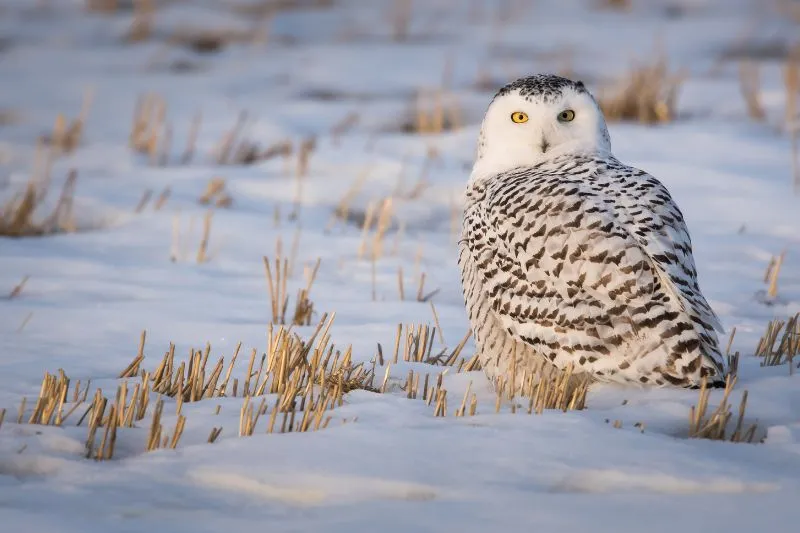
Snowy owls prefer to stay away from vertical cliffs and high mountains, normally at elevations below 300m. The white bird also resides on river banks or high terraces near streams and lakes3 (source: E. Potapov and R. Sale, The Snowy Owl, 2013).
However, in more alpine countries snowy owls choose to settle on a flat hilltop as it provides a good overview of the surroundings allowing them to stay vigilant and avoid surprising attacks from an eagle or eagle owl.
Snowy owls undertake migrations to more southern regions during the winter looking to inhabit similar open habitats to the arctic tundra such as grasslands, dunes, marshes, or agricultural fields.
In the winter snowy owls are seen in various environments including coastal areas, on sea ice, and even in urban surroundings. This is all due to food availability which is the driving force of habitat choice by snowy owls, but also as a survival strategy against interspecific competition4 (source: Jean-François Therrien, et al, Northeastern Naturalist, Vol. 24, sp7, 2017).
Where Does a Snowy Owl Nest?
Snowy owls do not have their nests in the trees like most birds but on the ground. They nest on hilltops, hummocks, and on gentle slopes in the Arctic tundra. Hummocks are little hills above the ground, usually less than 15m (50ft) in height, found in groups across fields5 (sources: Wikipedia and E. Potapov and R. Sale, The Snowy Owl, 2013).
Generally, it is important that the nest is on an elevated terrain so that the incubating owls have a good view of the surroundings and look out for potential dangers. Snowy owls nest on slopes and more raised areas also because less snow is collected there and it melts faster.
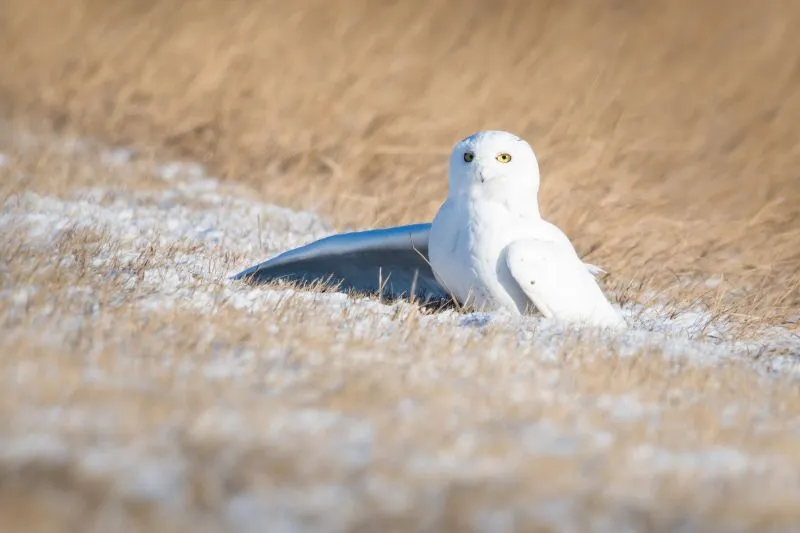
In flat tundra habitats, like northern Alaska, snowy owls locate their nest on raised and well-drained parts of the polygon. However, in the high tundra or on tide flats the nests of snowy owls can be nearby little lakes, and sometimes even on a salt-water marsh6 (source: O. J. Murie, The Condor, Vol.31, Issue 1, 1929, pp.3–12).
The nest of snowy owls is a shallow depression in the ground dug out by the female owl. Unlike other birds’ nests, those of snowy owls are not made from protecting materials like twigs and mud. Snowy owls’ nests have feathers in them, with grass, lichen, or moss seen occasionally in them.
Snowy owls are monogamous birds and often with one mate in pair for life. However, occasionally polyandry and polygyny are observed, meaning that one female mates with multiple males or one male – with several females.
Do Snowy Owls Live in Burrows?
ㅤ
Snowy owls are ground dwellers but do not live in burrows. Their nests are in the shape of a shallow hole covered in molted feathers on top of a hill, allowing the owl to have a good overview of the surroundings.
Do Snowy Owls Hibernate or Migrate?
Snowy owls do not hibernate, and to be precise, they do not exactly migrate either. They spend the summer in the Arctic tundra which is highly abundant in lemmings that snowy owls feed on. When the snow falls in the tundra, snowy owls do not migrate to warmer latitudes, like some birds, they move further south to areas where prey is plentiful but still cold.
However, snowy owls are still considered highly nomadic birds which in search of suitable productive habitats might fly over large distances.
For further information on the migration of snowy owls or if you are curious to know how far they fly read our full article on whether snowy owls hibernate or migrate.
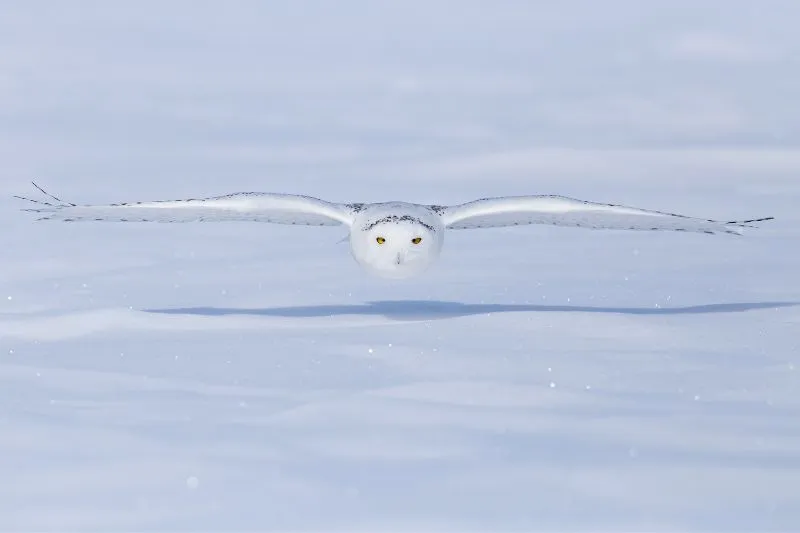
Where Do Snowy Owls Come from?
Snowy owls come from North America where they separated approximately 4 million years ago from another owl. Their evolution of white plumage was a result of the natural selection of camouflaging to the snowy-white environment and allowed them to extend their habitats to the Arctic7 (source: D.W. Holt, Journal of Raptor Research, Vol. 56, No. 4, pp. 440-454, 2022).
One of the earliest records of snowy owls is in Lapland in 17328 (source: S.W.Harris and C.F.Yocom, Record of Snowy Owl in California, Division of Natural Resources).
What Time of the Day is Best to See a Snowy Owl?
Snowy owls, unlike most owls, hunt both day and night which makes them diurnal. In the summer, when in the Arctic days can be extensively long, they feed during the day.
However, snowy owls are most active during the twilight hours of dusk or dawn, so that would be the time when the chances to glimpse a snowy owl are highest9 (source: IUCN).
Where Is the Best Place to See a Snowy Owl?
Snowy owls are very rare birds, inhabiting specific areas which are usually not populated or highly urbanized. However, here we will give you some tips on how you might spot one.
Snowy owls are not fans of forests, so the best place to see one would be in an open area such as agricultural fields and pastures, on top of a hill, or at the crest of a dune. Snowy owls can be seen on telephone poles and fence posts which they use as lookout points. Also, if you are looking for a flying snowy owl, you should keep your eyes close to the ground10 (source: Cornell University).
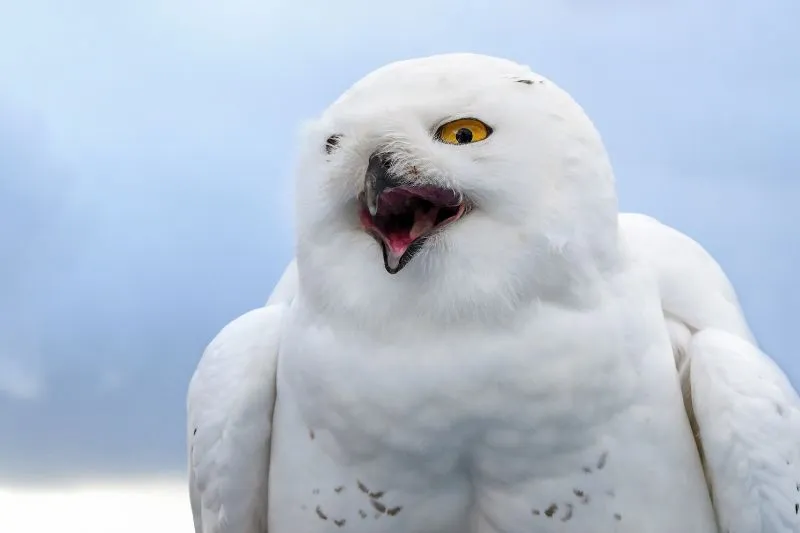
Related Questions
Do Snowy Owls Live in The Arctic or Antarctica?
Snowy owls live in the Arctic and are found only in the Northern Hemisphere. Antarctica is the cold continent at the south pole and snowy owls do not inhabit its grounds. It is no coincidence that snowy owls are also called Arctic owls.
Can You See Snowy Owls in The United States?
Yes, you can see snowy owls in the northern regions of The United States. Although they in the summer they breed in the Arctic they are also seen breeding in Alaska. Actually, there is a chance that a snowy owl appears in all 50 states, but this is not common and is possible only during a year of mass movement south (aka “irruption”)11 (source: O. J. Murie, The Condor, Vol.31, Issue 1, 1929, pp.3–12).
Do Snowy Owls Live in The Taiga?
Snowy owls can visit the Taiga temporarily in the winter but this is not their preferred habitat. The taiga is a subarctic forested region that is located between the arctic tundra in the north and the temperate forests in the south12 (source: National Geographic).
Where Do Snowy Owls Live in the Summer?
In the summer snowy owls live in the Arctic tundra where they spend the season breeding. During this time they also inhabit Alaska, eastern Canada, and Greenland.
Where Do Snowy Owls Live in the Winter?
In the winter snowy owls move south towards the northeast United States, southern Canada and in the northern regions of Eurasia.
Do Snowy Owls Live in Alaska?
Yes, snowy owls live in Alaska. They usually inhabit this region during the summer when food there is plentiful and this is crucial for the birds while breeding.
Why Do Snowy Owls Nest on the Ground?
Snowy owls nest on the ground in elevated areas such as hummocks, hills, or slopes. They inhabit treeless, open tundra environment which gives them a good overview of moving prey but also allows them to see easily predators and avoid sudden attacks from an eagle, for example.
Do Snowy Owls Live in Europe?
Yes, snowy owls can be seen in the northern parts of Europe usually during the winter.
Do Snowy Owls Live in Canada?
Yes, snowy owls live in Canada. During the winter, snowy owls move south from the arctic tundra to Canada. For instance, they are seen to feed on wintering ducks around the Belcher Islands13 (source: G.J Robertson, Journal of Raptor Research, Vol. 37, No. 2, 2003, pp. 164-166).
Do Snowy Owls Live in the UK?
Snowy owls can be an occasional migrating visitor in the northern parts of the UK but it is not common for them to live there. To see a snowy owl, it must be very cold in the UK. However, there are records from the 60s of snowy owls that have occasionally bred in the Shetlands14 (sources: M.Robinson and D.Mecker, Snowy Owls on Fetlar and British Wildlife Centre).


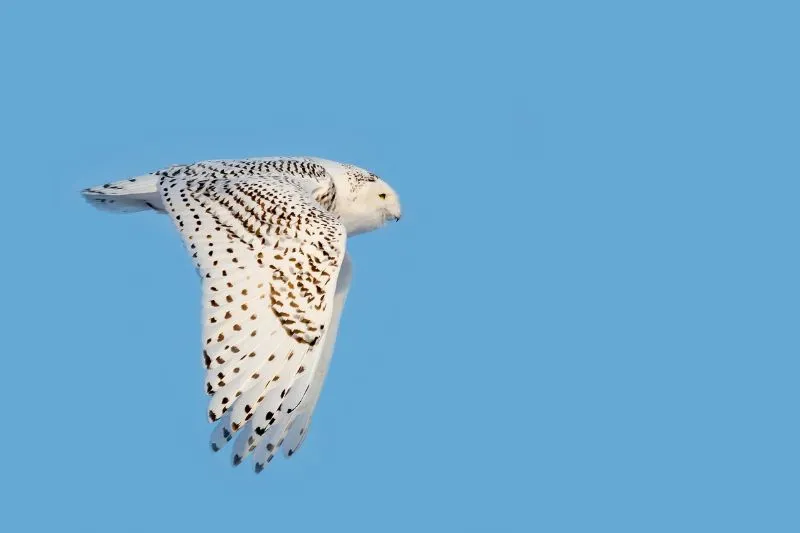
![Read more about the article 15 Curious Facts About Snowy Owls [#10 Will Surprise You!]](https://polarguidebook.com/wp-content/uploads/2023/02/Snowy-Owl-Facts-300x200.jpg)

![Read more about the article Are Snowy Owls Nocturnal? [Sleeping Habits Revealed]](https://polarguidebook.com/wp-content/uploads/2023/01/Snowy-Owl-Closeup-300x200.jpg)